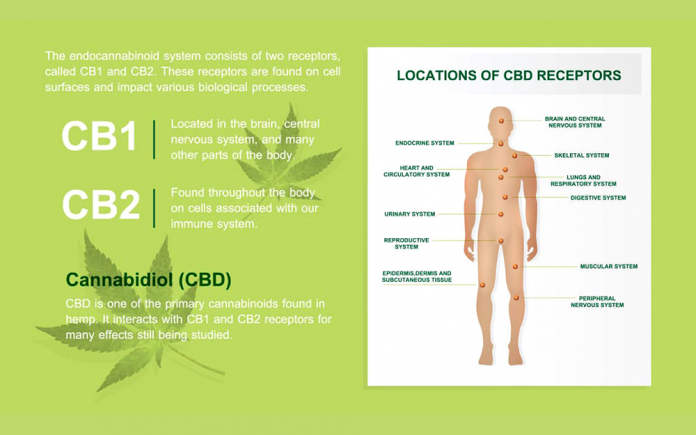
By M. Wheel-Zot
The Endocannabinoid System or (ECS), discovered over three decades ago- is the substantial grand master system and regulator of homeostasis in the human body and works with the nervous system. A bodies system that will rule the body’s health status of:
- Mental Health
- Physical Health
- Inflammation
- Anxiety
- Variety of Neurological Disorders
- Arthritis
- Indigestion
- Muscle Soreness
- Swelling
- Body Sprains
Dopamine-deficiency-related disorders have been linked to the implication of the endocannabinoid system. This may include ADHD, autism, schizophrenia, Parkinson’s disease, Huntington’s disease, and other neurological disorders. The complexities of the endocannabinoid (ECS) explains that a dysfunction of dopamine due to infant disability, or adult on set disability can cause manifestations of ADHD.
Recent science and research reveal that having a balanced ECS system is one of the receptors keys of maintaining focused and healthy neurological balance among the body. As explained in previous articles, the endocannabinoid system is combined with CB1 and CB2 receptors. These proteins are activated by other cannabinoids helping to create dopamine and the endocannabinoid system, which is a reciprocal relationship, in how dopamine affects the ECS system, and how cannabinoids affect the dopamine system.
Animal subjects have proved that the role of dopamine in modulating the endocannabinoid system, resulting in a healthy fluctuation of CB1 receptors and increased anandamide; (is a fatty acid transmitter) levels in people with Attention-deficit/hyperactivity disorder or ADHD. This implements that some homeopathic and pharmaceutical medicines can help restore CB1 function and it may be effective in helping some people with attention deficit hyperactivity disorder. Further linked to helping restore healthy receptors to those with other neurological disorders.
- Cannabinoid receptor type 1 (CB1): also known as cannabinoid receptor 1, is a G protein-coupled cannabinoid receptor that in humans is encoded by the CNR1 gene. The human CB 1 receptor is received in the peripheral nervous system and central nervous system.
- The CB2 receptors:are mainly found and attached to white blood cells, in the tonsils and in the spleen. The immune cells also express CB1, although there are fewer of them than CB2. In the immune system, one important function of the cannabinoid receptors is the regulation of cytokine release.
- Cytokine: small proteins that are important in cell signaling. Cytokines are peptides and cannot cross the lipid bilayer of cells to enter the cytoplasm. They are immunoblotting agents that work with the autocrine, paracrine, and endocrine signaling.
- Endocrine System: A complex network of glands and organs. It uses hormones to control and coordinate your body’s metabolisms, energy levels, reproduction, growth, and development.
- Paracrine: paracrine signaling is a form of cell communication in which a cell produces a signal to induce changes in other yet nearby cells.
- Autocrine: the production of an extracellular mediator by a cell followed by binding of a mediator to receptors on the same cell to enable transduction.
- Mediator: A part of the nervous system that TRANSMITS impulses that draw out a response.
- Focal Adhesion Kinase: (FAK) is an essential gene protein that transmits signals from the extracellular matrix into the cytoplasm.
Autism spectrum disorder (ASD) portrays a rising faction of neurodevelopmental disorders whose symptoms have an unsound communication and social interaction with barriers or repetitive motor movements, frequently associated with neurocognitive disorders. However it is becoming a severe and chronic childhood disorder and is a prevalent learning disability in the special education classrooms. Further, there is no effective treatment for ASD yet available, because it’s neurobiological and ECS system is not widely understood. Yet, in subset patients diagnosed with ASD the neurological system was tested and it was found that patients with ASD amounted to both environmental (including the in-utero environment) and genetic factors. Where there is science there will always be aspirations for curing or helping treat anyone with a neurological disorder. That’s why it’s important to understand the Nervous system and the ECS system.
Although families and science are trying to understand the scientific reasons behind ASD; recent evidence shows that the following may put children at greater risk for developing ASD.
- Having a sibling with ASD
- Having certain genetic or chromosomal conditions, such as fragile X syndrome or tuberous sclerosis
- Experiencing complications at birth
- Being born to older parents
- 2020 (Centers for Disease Control) CDC had placed the estimate at 1 in 54 children were diagnosed with autism compared to 1 in 150 children in 2000.
- Boys are 4 times as likely as girls to be identified as having ASD.
In treating and working with the complexity of the Nervous System and the Endocannabinoid System or (ECS) there is always a sparkle of hope that there can be a homeopathic route to healing a system that is rooted in mother nature’s natural cures.
Please be advised: Always consult with your health care provider when exploring other methods of healing.
For any question about CBD and other homeopathic medicines you may contact:
The 420 Bank & Lounge
Downtown Palm Springs
296 Palm Canyon,
Palm Springs Ca.
(760-318-6877)












































